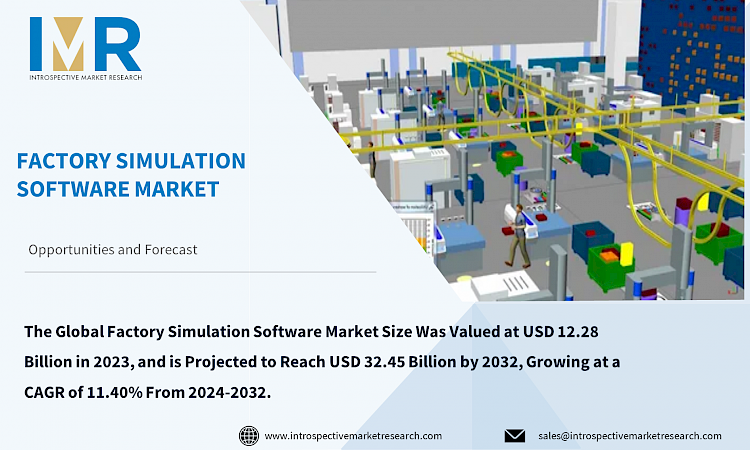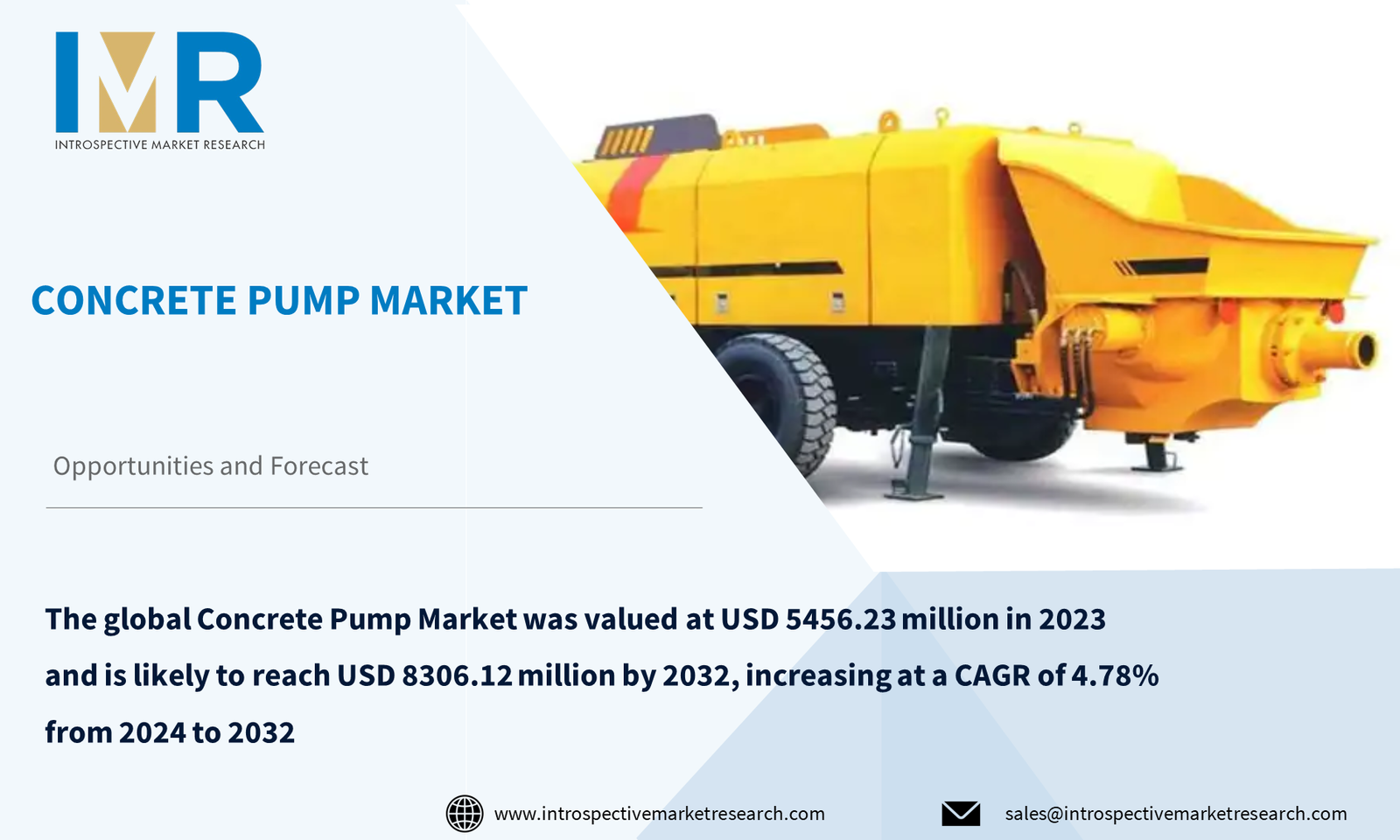Factory Simulation Software Market
According to a new report published by Introspective Market Research, titled, “Factory Simulation Software Market by Deployment Mode and Application: Global Opportunity Analysis and Industry Forecast, 2024–2032,”
the Global Factory Simulation Software Market Size Was Valued at USD 12.28 Billion in 2023, and is Projected to Reach USD 32.45 Billion by 2032, Growing at a CAGR of 11.40% From 2024-2032.
Factory Simulation Software is a pivotal tool for modern manufacturing, allowing businesses to simulate and analyze their processes in a virtual setting. By enabling dynamic simulations of production workflows, this software helps organizations identify and resolve bottlenecks, optimize resource allocation, and enhance overall efficiency. The ability to test various scenarios virtually ensures that companies can make strategic, data-driven decisions, ultimately leading to cost-effective operations and improved productivity.
Additionally, this technology plays a crucial role in production planning, scheduling, and quality control. It allows businesses to create practical schedules that balance resource utilization and ensure timely delivery of products. Furthermore, the software provides a virtual platform for optimizing factory floor layouts, which enhances space and operational flow. By simulating the production process, organizations can fine-tune their mechanisms to improve quality control. Factory Simulation Software also offers realistic training environments for personnel to get acquainted with new processes and equipment, fostering skill development and ensuring smooth transitions to new production methods.
According to the global Factory Simulation Software market analysis, the market is divided into Type, Deployment Mode, Application, and Region. By Type, the market is categorized into 2D Software and 3D Software. By Deployment Mode, the market is categorized into Cloud and On-Premises. By Application, the market is categorized into Automotive, Logistics, Chemicals, Food, Agriculture, and Electronics & Semiconductor. By geography, it includes North America, Europe, Asia-Pacific, and LAMEA markets. Further, the report also covers the strategies adopted by key market players to sustain a competitive environment and increase their market share.
The growing demand for increased efficiency and productivity is driving the expansion of the Factory Simulation Software Market. Industries, particularly in the automotive, electronics, and pharmaceutical sectors, are increasingly recognizing the need to optimize their manufacturing processes to remain competitive. Factory simulation software plays a crucial role by enabling businesses to simulate real-world production scenarios, identify operational bottlenecks, and refine workflows, thereby enhancing overall productivity. As companies emphasize resource optimization and efficient production planning, the software's realistic virtual environments for training further underline its importance, aligning workforce skills with evolving manufacturing needs. The expanding automobile sector presents significant opportunities for the Factory Simulation Software Market. As the demand for innovative solutions surges, simulation software becomes vital in optimizing complex manufacturing processes in the automotive industry. It allows manufacturers to streamline operations, improve factory floor layouts, and enhance workflow, ultimately increasing operational agility. Additionally, the software's capability to simulate production processes aids in quality control by identifying potential issues and optimizing inspection processes, ensuring higher quality in the final product. Embracing simulation software is essential for automotive manufacturers to stay competitive and leverage growth opportunities effectively.
Global Factory Simulation Software Market, Segmentation
Factory Simulation Software Market Segmented based on Type, Deployment Mode, Application, and Region.
Deployment Mode:
The Deployment Mode segment is further classified into Cloud and On-Premises. Among these, the cloud sub-segment accounted for the highest market share in 2023 The Cloud segment is set to dominate the Factory Simulation Software Market due to businesses' growing preference for cloud-based solutions, which offer scalability, flexibility, and cost-effectiveness. Cloud deployment provides manufacturers with strategic advantages such as remote access to simulation tools and data, fostering collaboration and real-time decision-making. This adaptability aligns with industries' evolving needs for dynamic, accessible solutions to optimize manufacturing processes, making the Cloud segment a frontrunner in the market as organizations prioritize digital transformation and leverage cloud technology.
Application:
The application segment is further classified into Automotive, Logistics, Chemicals, Food, Agriculture, Electronics & Semiconductors. Among these, the Automotive sub-segment is anticipated to show the fastest growth by 2032. The Automotive segment leads the Factory Simulation Software Market, driven by the sector's complex manufacturing processes and the need for advanced optimization solutions. This software allows automotive manufacturers to simulate, analyze, and enhance production scenarios, streamline operations, identify inefficiencies, and make data-driven decisions. The intense competition and rapid technological advancements in the automotive industry further fuel the adoption of simulation software, helping companies optimize production, reduce costs, and improve quality, solidifying their dominant market position.
Region:
The Factory Simulation Software market in North America is projected to grow fastest by 2032. North America is set to dominate the Factory Simulation Software Market, driven by its strong automotive, aerospace, and electronics manufacturing ecosystem. The region's emphasis on technological innovation and digital transformation spurs the adoption of advanced simulation solutions to optimize processes and enhance efficiency. Early adoption of Industry 4.0 practices and the presence of major software vendors and technology innovators further solidify North America's leadership in this market.
Some of The Leading/Active Market Players Are-
- Altair Engineering Inc. (U.S.)
- The MathWorks Inc. (U.S.)
- Autodesk Inc. (U.S.)
- Cybernet Systems Corporation (U.S.)
- Bentley Systems Incorporated (U.S.)
- PTC Inc. (U.S.)
- CPFD Software LLC (U.S.)
- Design Simulation Technologies Inc. (U.S.)
- Synopsys Inc. (U.S.)
- Ansys Inc. (U.S.) and Other Active Players
Key Industry Developments
- In July 2023, Ansys (US) partnered with EikoSim to strengthen simulation validation. The partnership integrates EikoSim’s image analysis with Ansys Mechanical and LS-DYNA software, enhancing engineering simulation with EikoTwin’s validation capabilities.
- In March 2023, Simulations Plus, Inc., a provider of modeling and simulation software and services for pharmaceutical protection and effectiveness, announced that it joined into a cooperative research contract with the Institute of Medical Biology of the Polish Academy of Sciences to develop new Compounds.
Key Findings of the Study
- Automotive Segment held the market's major share, accounting for nearly 52.50 % of the total Factory Simulation Software market.
- The North American region is expected to continue to lead the market followed by APAC during the forecast period.
- Global Factory Simulation Software Market Size Was Valued at USD 12.28 Billion in 2023 and is Projected to Reach USD 32.45 Billion by 2032, Growing at a CAGR of 11.40% From 2024-2032.







